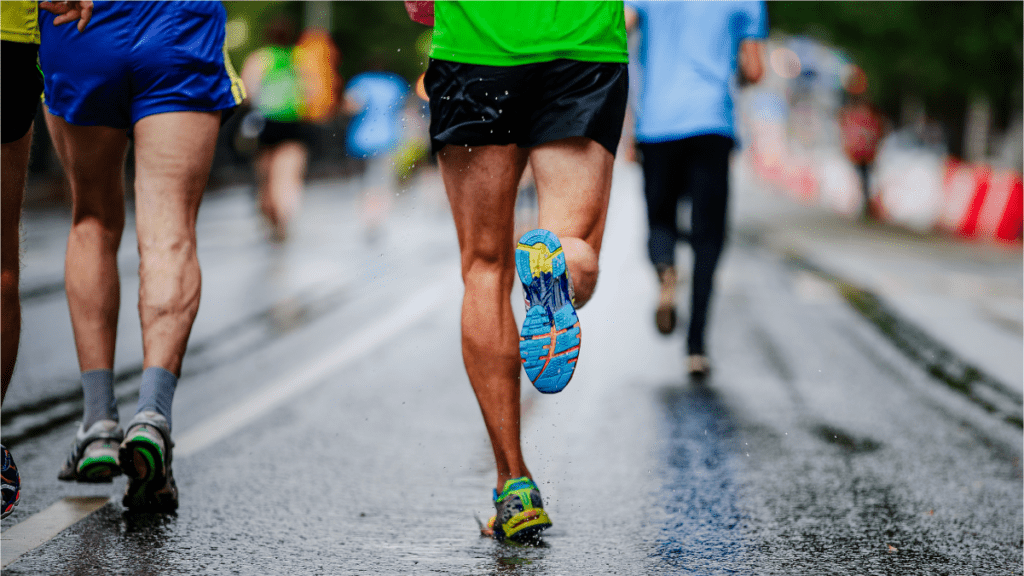Here are some top tips for anyone getting into long-distance running.
Did you know that the average runner takes about 40,000 steps to complete a marathon – the ultimate form of long-distance running?
It’s an impressive feat by any standards, and not an easy one to achieve. Though it varies by one’s fitness level, training for a marathon generally takes months of dedication. But where do you even begin preparing for such a task – and how can you tell when you’re ready?
First, here are some reasons why it’s essential to prepare your body before running a marathon (or any long-distance running event):
- Bone & muscle stresses. First, each of those 40,000 steps constitutes an impact stress, hitting against the heel and travelling up the leg. This actually equates to a 7-9x body-weight impact through the knees, for every step taken while running. To prevent this from causing problems during or after running, you’ll need to build some resilience in these places. To be honest, even if you’ve no intention of running a marathon, keeping your body well-used to these stresses is very healthy – helping to prevent arthritis in the long-term.
- Heart & lung strength. While running, the rate at which blood needs pumping throughout your body actually quadruples. It’s imperative, therefore, that your heart and lungs are accustomed to this level of exertion over a significant period.
- Hydration. In order to keep your body temperature at a safe level while running, your skin temperature increases 40-fold. This means that, over the course of a marathon, you’re liable to sweat around 6 litres of water. Proper hydration is essential to ensure your body has enough stores to maintain its performance. During a marathon you will likely need to supplement this, since you’re sweating out electrolytes (such as sodium, potassium, chloride) which are important in nerve functioning and help muscles to contract.
“42 kilometres, 40,000 steps. 4x increase in blood-flow, 40x increase in skin temperature. 6 litres of water lost in sweat.”

Training for long-distance running
It commonly takes a first-time marathon runner between 5-6.5 hours to complete a marathon – constituting a distance of precisely 42.195km (26 miles & 385 yards). The time it’ll take to prep your fitness for this will vary based on how active you already are. If you’re sedentary, it may take up to 6 months of diligently building up your running tolerance. If you’re already active, however, and have fairly consistent exercise, then keeping to a regular running plan for 3-4 months will generally get you where you need to be.
General guidelines for long-distance running plans
Healthy running plans run weekly, not daily. This allows your body sufficient time to rest and recondition after running. The London Marathon’s official website offers some fantastic training plans, catering to different levels of experience. They provide great figures for you to know what specific mileage you should be aiming for each week – increasing steadily as you get further along, and then tapering off as you near race-day. In other words, the plans intend you to start exactly 16 weeks prior to the marathon. If you start your prep a few weeks early, though, there’s nothing wrong with repeating some weeks a couple of times – especially if you found that week particularly hard going.
In general, you’ll be out running several times a week, running both short- and long-distance. Every couple of weeks you’ll implement a manageable increase in your total distance (no more than 10% beyond what you’ve achieved thus far). Make sure to incorporate a long run into each week of training, but don’t overdo it. A good rule of thumb while running is to maintain a pace where you can easily hold a conversation. That’s one reason why it can be helpful (not to mention motivating) to have a running partner.
Finally, make sure to stretch before and after each run! We’ve noticed a lot of guides forget to mention this, but it’s critically important – both to help your body recover, to maintain mobility and to minimise the possibility of injury. Here are some helpful pointers.
“Make sure to maintain a pace where you can easily hold a conversation.”
Useful training tips for long-distance running
- Make your longer runs specific. Test your nutritional strategy, test your equipment, and be aware of running conditions (e.g. temperature, surface, elevation). This will make your runs much more efficient, since not only are you improving your endurance, but you’re also learning more about your body’s performance and how it changes based on external factors.
- Focus on sustainability. Prioritise enjoying your workouts – you’re preparing for a massive task, so make sure to relish the journey you’re on.
- Ramp up slowly. Slow progression isn’t just more manageable; it’s both safer and more effective! Building up the aerobic base to complete marathon-distance runs takes time, especially if you want to remain injury-free. If you’re increasing your volume, make sure only to bump up by up to 10% of what you do currently.
- Be fair to yourself. Understand that life will often get in the way, whether it be work, travel, illness, ‘sleep hygiene’ or any other life stressors. It is okay to miss a work-out. Don’t beat yourself up about it – just get in the highest volume you reasonably can, given your physique and life constraints. It’s not worth stressing your mind and body just to squeeze in this work-out. If you do, this can lead to injury and even more time out.
- If you’re struggling to get in the running volume, many have found it easier to source it from cross-training (such as cycling or swimming) or commuting.
How to create a nutritional strategy
On average, runners consume 30-60g of carbohydrates per hour for their energy while running. You can ingest this in the form of energy gels, or from more natural sources such as bananas. Whatever your chosen fuel source, be sure to practice with it before race-day, to get your body used to running and eating. Finding out what works for you takes time, and potentially a run or two with an upset stomach.
Water-intake is also essential: 400-800ml per hour, with warmer and more humid climates pushing the upper end of the scale. Find out whether there’ll be water stations on the course you’re running, or figure out an easy way of carrying it with you.
Think ahead about how you’ll carry your water and fuel on race-day. If necessary, research sponsors ahead of time and adapt your strategy according to what race organisers are offering out on the course. This is important because you should not be changing your intake on race-day. Giving your body something it doesn’t expect can cause stomach complaints and other issues that could jeopardise your run.
In short, having a nutritional strategy will help avoid run-ending complications on the day.
What to expect while running
As we made a point of clarifying earlier, your body has to work very hard while running. This high-intensity activity, stretched over several hours and dozens of miles, is what makes long-distance running so challenging. All your prep will pay off in making this process easier for your body to manage.
Apart from the dramatically increased heart rate and heavier breathing, higher body heat and sweating, there are other physiological effects that you need to take into account. For one thing, during longer runs it’s common to experience cramping in some form. This is because when you sweat, you lose electrolytes that aid nerve function and help muscles to contract. Taking isotonic sports drinks or gels on a run will prevent this happening, as they contain those important electrolytes to supplement what you lose.
Electrolytes aren’t all you need to keep going, however. During a marathon your body will burn through its stores of glycogen – kept in muscles and the liver. This makes the final 10km of a marathon notoriously challenging, since you’ll often have depleted your stores by this point.
As mentioned earlier, you can avoid this with a proper nutritional strategy. 30-60g of carbs, and 400-800ml of water – every hour – will keep you topped up. Make sure you can carry with you all the fuel you’ll need, or otherwise ensure that this will be provided at intervals during the run. Also, make sure not to use different brands or forms of sustenance on race-day. You want to avoid giving your body anything it’s unfamiliar with. If you’re relying on refuel stations along the course, make sure to train using the same products they’ll provide – do research on the organisers and sponsors for your target event.
What to do if you experience joint pain while running
Although it always pays to take notice of your body, pain does not always equal damage. Often when you experience pain during exercise, your body is trying to tell you something. This could be lack of sleep, poor nutrition to support your increased activity, amplified stress at work due to an impending deadline – the list of possibilities is pretty much endless. To rectify this, analyse all areas of your life and find problem areas. If you can spot places where you might be able to make positive changes, e.g. ingesting healthy snacks throughout the day, then implement them and see if it makes a difference during your runs.
An interesting note: some research suggests that cycling between multiple pairs of running shoes can help prevent injuries.
Do joints actually wear out from overuse?
If pain persists or worsens, however, then you should stop and consult a GP or physio.
Race-day tips and pointers
Stick to your pace. It’s easy to get swept away by the excitement of the day, and everyone starts out too quickly. Find your rhythm and pace. It doesn’t matter if people are passing you – think about the longevity of your race. This is especially true of a marathon, since you have 42km to complete.
Avoid using any new products on race day. This includes any energy gels you have not tried before, as this may cause GI distress and end your race. Here is a fantastic guide on proper marathon nutrition.
What to do after you finish
Remember when we said your skin’s temperature increases by up-to 40 times while running a marathon? This is effectively your body pumping heat away to maintain a safe internal temperature. However, when you reach the finish line and can finally collapse into the warm glow of your victory, this skin heat can actually be dangerous. Now that you’ve finished exerting yourself you’ll most likely stop completely, and your body will begin rapidly haemorrhaging heat before it’s able to bring your skin temperature back down again. Don’t let this happen!
You’ll often see long-distance runners wrapping themselves in reflective foil, right after they complete their run. This is because they know it’s important to conserve their body temperature. Even though the last thing you’ll want to do is stay hot, you must ensure – somewhat counterintuitively – that you wrap up warm. If you don’t, and your body can’t maintain a safe internal temperature, this can be life-threatening.
If you can manage to warm down with stretches, then that’s fantastic. After you’ve somewhat recovered, you’ll want to go out straight away to celebrate your achievement (also very important!) However, don’t forget that refuelling is imperative. Get your supporters to bring you a refuelling sports mix containing all the necessary post-race carbohydrates, protein, and water.

